Nature is constantly changing or evolving and with that, the natural species are evolving too. Life underwater is not just mysterious, but it can also unfold interesting and comical aspects to it. Starting from the humphead fish to the trumpet fish, the different varieties of fish never cease to amaze us.
Take a deep dive to find out more about the different adaptations, behaviour, and characteristics of the aquatic jesters. Get ready to dive into the underwater realm as we uncover the marvels of these underwater wonders.
20 Hilarious Fish With Big Foreheads
1. Midas Cichlid
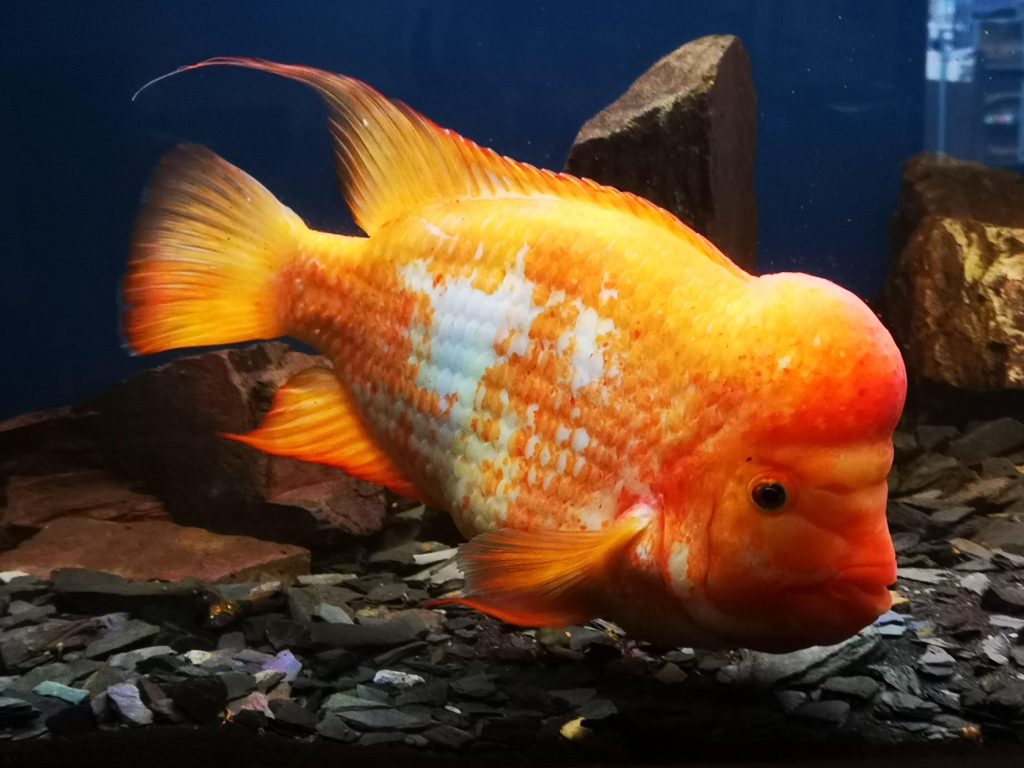
- Scientific name: Amphilophus citrinellus
- Head size: 1/3 to ½ of their body length. Their body length is usually 10 to 14 inches.
- Weight: 1 to 2 pounds
- Where are they found: Freshwater Tropical Region
This fish species is specific to Tropical and Central America. As they age, they develop vivid colors and bright hues. Both male and female species of Midas Cichlid develop a nuchal hump or a forehead swelling, which is due to edema or a modified nuchal hypodermis.
The hump becomes more prominent in males, but it is fascinating to note that it is only prominent part-time. The hump is the most prominent during breeding season which is probably because the fish species need to attract mates.
Once the breeding season is over, the hump decreases in size until the hump grows again during the next mating season. Then, this fish species attracts new fish for breeding and raising the next generation.
2. Kamfa
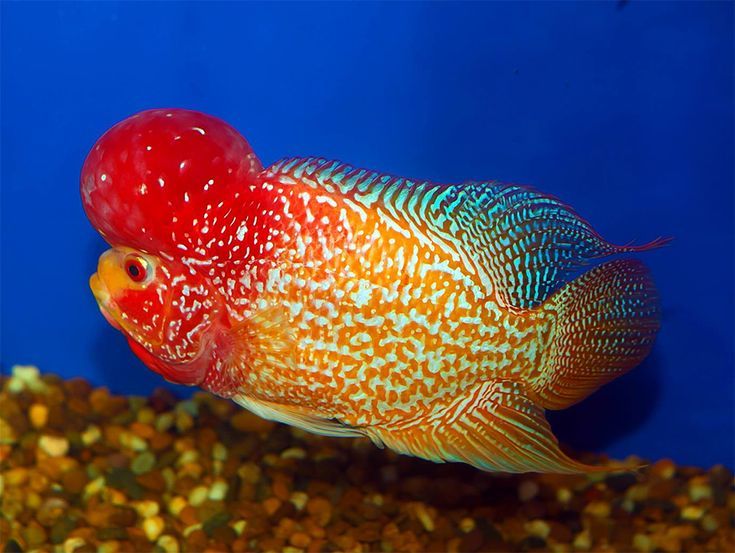
- Scientific name: Flowerhorn cichlids
- Head size: 1.2-2 inches
- Weight: 1-1.5 lbs
- Where are they found: Aquariums as they are usually bred
The Kamfa flowerhorn fish species grows as a consequence of selective breeding. They are a genetic mix of Blood Parrot and Red Devil cichlids, leading to shared characteristics. Selective breeding also produces various strains of flowerhorns, each with distinct looks and sizes.
This fish species is omnivorous and their diet consists heavily of proteins. As the fish enter the fry stage or when they are ready to eat on their own, they gradually need to increase their protein intake.
The protein intake gradually decreases to 40% for adult flowerhorns that need plant-based food too. The living conditions of the flower horn fish vary. Their optimal water temperature is between 82 to 88 degrees Fahrenheit. The Kamfa fish lives in water that has a pH of up to 8.
Flowerhorn cichlids are of various types such as the Zhen Zhu, Thai Silk, Kamfa Flowerhorn, Golden Base Fader, Gold Monkey, etc.
A point of notice about these fish is that they have nuchal humps on their foreheads, also known as koks. The koks consist of a special gel that is squishy to the touch. This fish species is also transparent under a special kind of LED light.
3. Napoleonfish
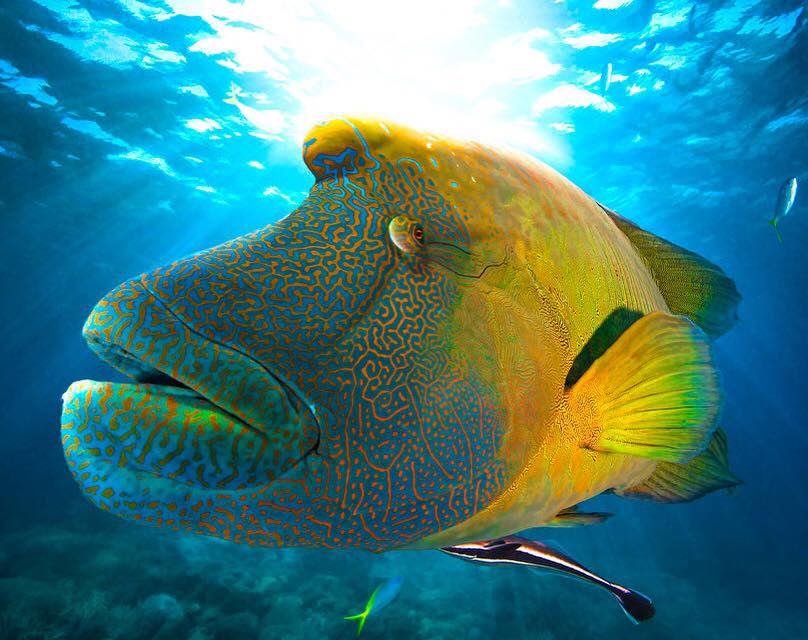
- Scientific name: Cheilinus undulatus
- Head size: 50 per cent of the total body length of 60.0 cm
- Weight: 100 to 400 pounds
- Where are they found: Warm tropical region of the Indo-Pacific Ocean
You may find it interesting to know that the Napoleon fish gets its name from the distinct hump on their foreheads. It’s this hump on their forehead which makes them appear similar to a French emperor known as Napoleon Bonaparte.
The males of these fish species are light green to aqua or purplish-blue in colour with intricate blue patterns on their heads and bodies.
Most of the Napoleon fish species are born as females. It takes them around five to seven years to reach sexual maturity. These fish form groups known as harems, where there is one dominant male that fertilizes other female fish.
In case of an absent dominant male, one of the female fish will change her sex and replace the dominant male.
The Napoleon fish play a crucial role in maintaining a healthy coral reef environment as they eat up other toxic fish species. This ensures that a healthy balance is maintained in the ecosystem where the Napoleon fish live.
4. Dolphinfish
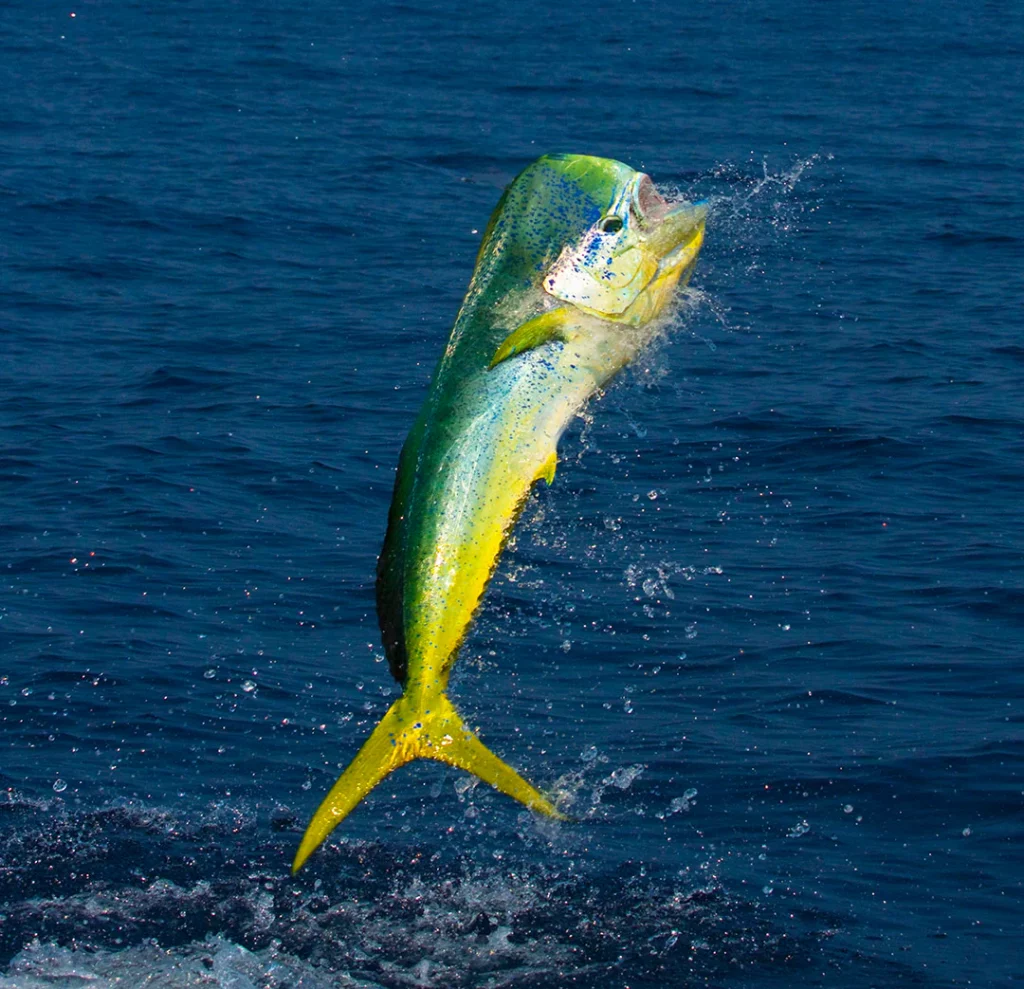
- Scientific name: Coryphaena hippurus
- Size of dolphinfish: Generally 3 feet in length
- Weight of dolphinfish: Approximately weighs 14 kg
- Where are they found: Warm oceanic waters in subtropical areas
There are two different species of dolphinfish- Coryphaena hippurus and Coryphaena equiselis. If we had to talk about the physical characteristics, the heads of male dolphinfish bulge out.
These fish can usually be located in the Indian, Pacific and Atlantic Oceans. They live in tropical waters that have a temperature of around 90 degrees. Dolphinfish usually stay near the surface of the water and they are most prominent in the Gulf regions or Caribbean regions.
You may be surprised to know that the dolphinfish and dolphins are different and that they have nothing in common. While dolphins are warm-blooded mammals with live births, the dolphin fish is actually a fish. The dolphinfish, originally belonging to the “Dolfyn” family, does not belong to the same scientific family or genus as the warm-blooded dolphins.
5. Green Humphead Parrotfish
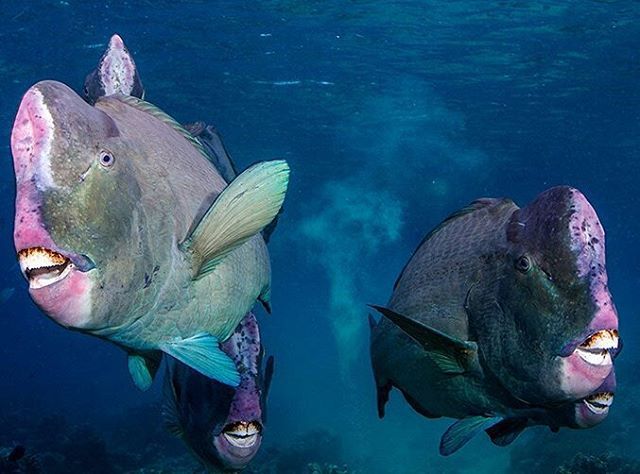
- Scientific name: Bolbometopon muricatum
- Size of green humphead parrotfish:1.5 meters
- Weight: 46 to 80 kg
- Where are they found: Indo-Pacific region and the Red Sea
The humphead parrotfish is one of the largest in the species. They are found all over the Indo-Pacific regions, mostly in groups but sometimes stranded. These fish mature very slowly and also breed in smaller numbers.
Widely known as bumpheads, these fish increase to a length of 1.3 meters and can have a weight of up to 46 kilos. Bumpheads have a slow growth rate.
Moreover, they do not reach sexual maturity until much later in life. Juvenile bumpheads are found in shallow lagoons and sea beds. Mature bumpheads are present in outer lagoons and sea reefs.
These fish eat benthic algae and also live coral. They contribute to reef deterioration and also its maintenance at the same time. Despite their large size and ferocious outward appearance, bumpheads are genuinely docile creatures.
6. Oranda
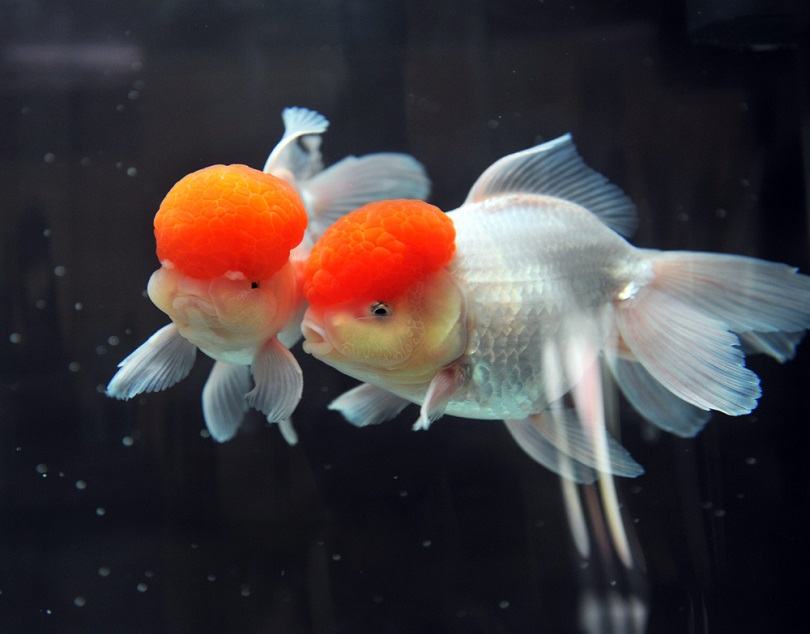
- Scientific name: Carassius gibelio forma auratus
- Size of oranda: 8 to 9 inches
- Weight: 100 grams to 600 grams
- Where are they found: Aquariums as they are selectively bred
Oranda goldfish are around eight to nine inches in length. They are available in a variety of hues, including orange, red, white, black, and even bicolor combinations.
Oranda goldfish comes from the Cyprinidae family. The fish can easily be identified by its bubble-like forehead called the Wen. The Wen is not visible until the fish is 2 years old.
Oranda goldfish need a neutral pH level of water, around pH 5 to 8 to survive. When the Oranda goldfish are around 2 years old, they reach maturity.
Oranda goldfish is omnivorous as it eats plant-based food and meaty foods at the same time. You can feed Oranda around 1-2 times a day.
7. Hump-headed Blenny
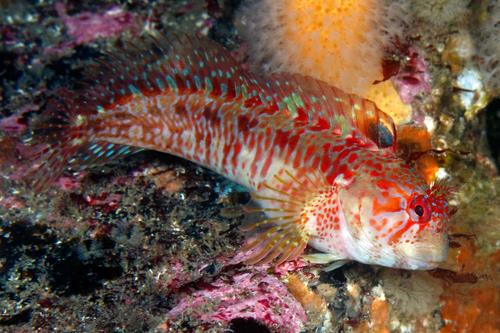
- Scientific name: Labrisomus bucciferus
- Maximum size of hump-headed blenny: 12cm or 5 inches
- Where are they found: Western Atlantic Ocean, typically in the Caribbean Sea
Hump-headed blennies live in regions such as Atlantic, Indian Ocean and also in coastal waters. They are also found in Spain, Portugal, Brazil and even the coastal areas of Argentina.
These fish can increase to a length of five inches. They also have a unique appearance, showing different colors and bulged out foreheads.
The hump-headed blennies also react quickly to any kind of posed dangers or threats. One common characteristic shared by blennies from the same family includes their oblong shape and elongated dorsal fin.
8. Humphead Glassfish
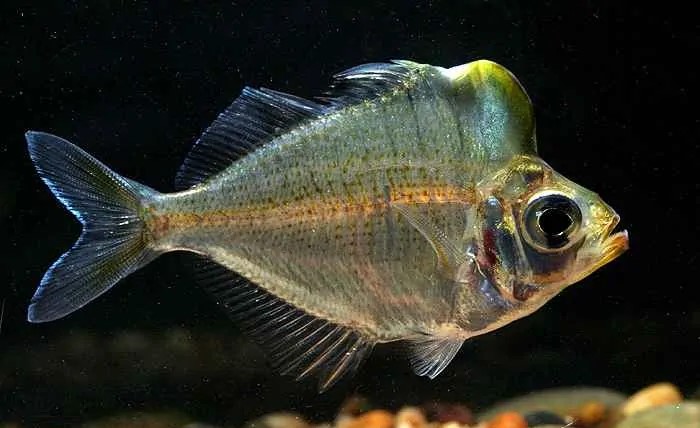
- Scientific name: Parambassis ranga
- Size of glassfish: Upto 4 inches or 10 cm
- Where are they found: freshwater habitats of Southeast Asia
The humphead glassfish is a member from the family Ambassidae. Unlike the humps that you can see on cichlids, the shape of these glassfish is thin. Both genders of the humphead glassfish have humps. More prominent humps can be seen on mature males of the species.
These fish usually dwell clear and shallow streams. Humphead glassfish appear to be opportunistic predators feeding on small fish, insects and other such larvae that inhabit the waters.
Just like any other glassfish, humphead glassfish are also fussy eaters. In the initial stages, live and frozen food needs to be used. Once the humpheads settle in the aquariums, they feed on bloodworms without any complaints or issues caused.
When kept in the aquariums, these fish can be a little aggressive towards each other.
9. Lionhead Cichlid
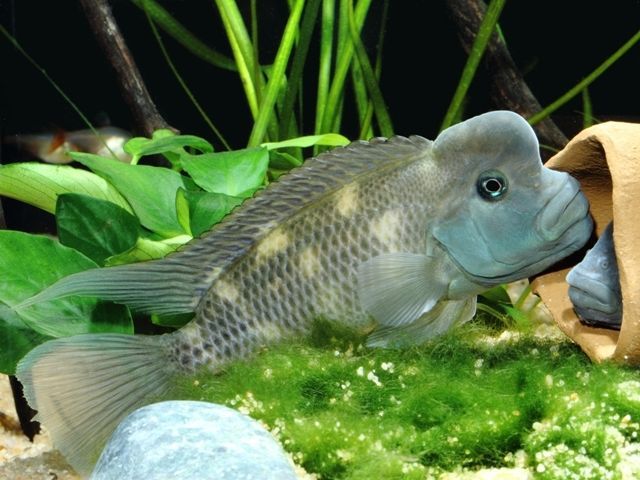
- Scientific name: Steatocranus casuarius
- Maximum size: Males- 4-½ inches/ Females- 2 inches
- Where are they found: Lake Tanganyika in East Africa
This species is unique compared to others in the same family because it usually floats on top of the aquariums. The behavior that they demonstrate inside the aquariums is an adaptation to the behavior that they show in the wild.
In the natural environment, they usually inhabit the creeks and the streams. The Lionhead Cichlid is usually present in the Eastern African regions such as Congo and Zaire.
The reduced swim bladder makes it less buoyant than the other species of cichlids. When kept in aquariums, they feed on pellets and other dry food. They should have a varied diet consisting of animal protein and vegetables. These species are also easy to breed in suitable pairs.
10. Barreleye Fish

- Scientific name: Macropinna microstoma
- Size: 6 inches
- Weight: 2-5 oz.
- Where are they found: Northeast Pacific Ocean
Widely known for its strange-looking eyes, the Barreleye fish has transparent domes that sit on top of their foreheads. The eyes point upwards which enables them to spot the prey easily. They can also rotate their eyes forwards when needed.
Barreleyes generally feed on zooplankton. These fish species may also consume crustaceans enclosed in the tentacles of siphonophores.
Further studies have also been conducted on the eyesight of the fish. According to research quoted by scientists, the fish can rotate their eyes to the front to see their prey or the food they are eating.
11. Asian Sheepshead Wrasse
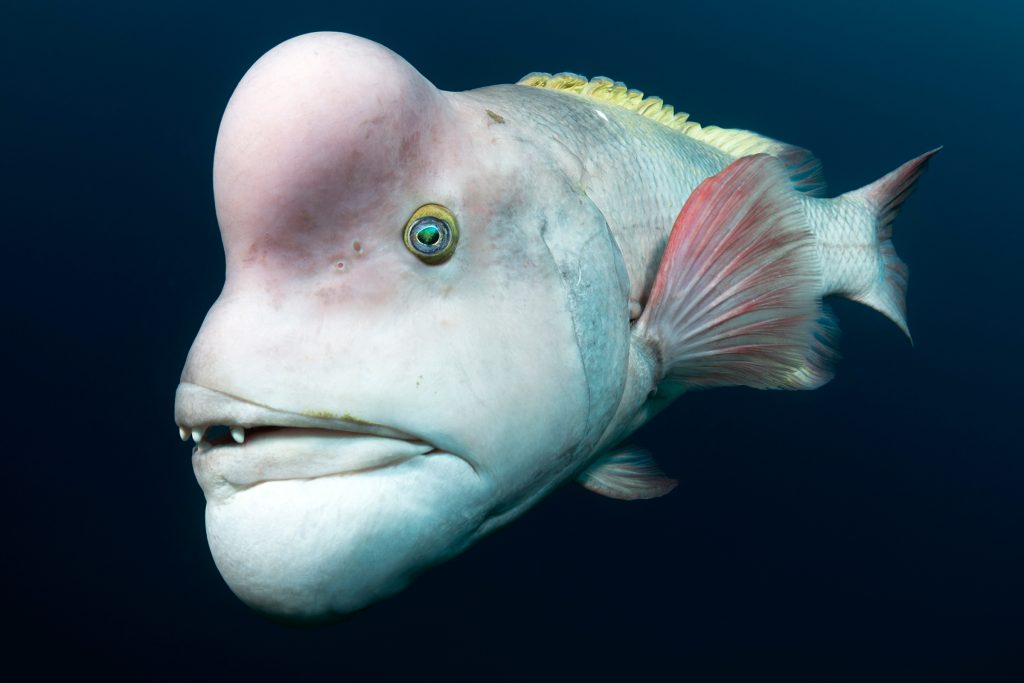
- Scientific name: Semicossyphus reticulatus
- Weight: Up to 32 lbs.
- Where are they found: Korean Peninsula, Japan, China
The Asian Sheepshead Wrasse, also known as adult Kobudai, is one of the largest wrasse species. They are found in seas, beds of Pacific Ocean and around the rocky reef of China, Japan and Korean Peninsula.
They are characterised by their yellow or orange bodies with white stripes running down the middle of their heads to their tails. Surprisingly, the juvenile Sheepshead lack any kind of bulbous protrusions on their heads.
These species feed on aquatic crustaceans, crabs, clams, oysters, shellfish and even zooplankton.
Besides this, it can also be noted according to research that all wrasses are born as females. Some change their genders to become males to start the breeding process. The fertilized eggs of these fish hatch 5 days after spawning.
12. Humphead Glassfish

- Scientific name: Parambassis pulcinella
- Size: Up to 10 cm or 3.9 inches
- Where are they found: Asiatic fish present in southeast Myanmar and other regions
An exciting addition to the aquarium, these fish can reach a length of up to 4 inches. Glassfish as the name implies has a transparent body and a lump on its forehead.
The glassfish belong to the Chandidae family, formerly known as the Ambassidae family. The fish has a divided dorsal fin and the lateral line extends to the tail fin.
Humpheads are freshwater fish, unlike some fish which prefer the brackish water environment. Generally peaceful, they are boisterous and energetic during their feeding times. They eat guppies or danio sized fish.
13. Bumphead Parrotfish
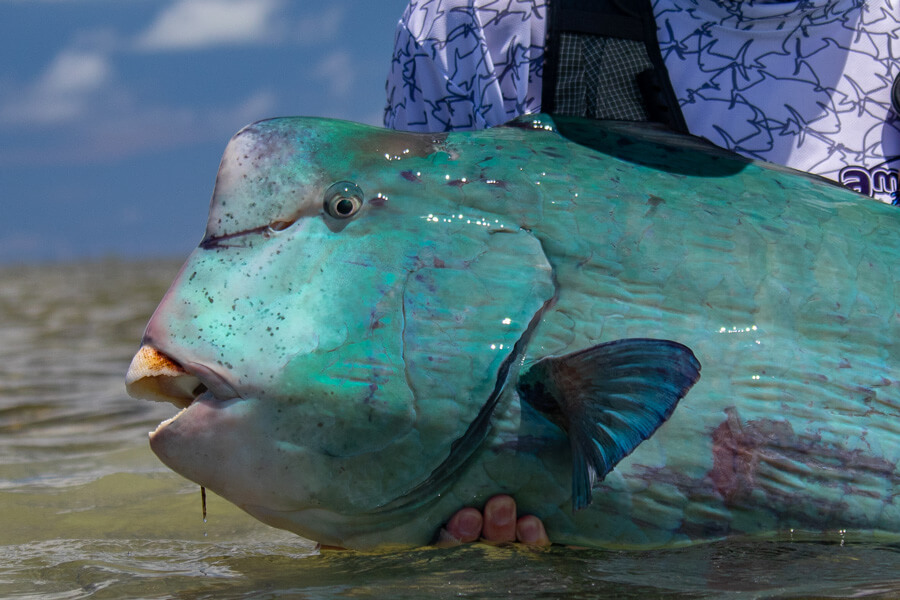
- Scientific name: Bolbometopon muricatum
- Weight: Up to 46 kilos
- Where are they found: Coral reefs such as Australia’s Great Barrier Reef, Indian and Pacific Oceans
The Bumphead Parrotfish can reach a gigantic length of 1.3 meters. It can weigh up to 46 kilos. Although the replenishment rates of these fish species are low, they are not yet listed as endangered species.
Live coral and benthic algae are the primary foods of these bumphead parrotfish. Much of the consumption of the bumphead parrotfish is passed out in their faeces, which makes them vital for the processes of the ecosystem.
It is easy for divers to spot bumpheads, so it is important that they do not shine a torchlight directly at them, to ensure the fish remain undisturbed.
14. Unicorn Surgeonfish
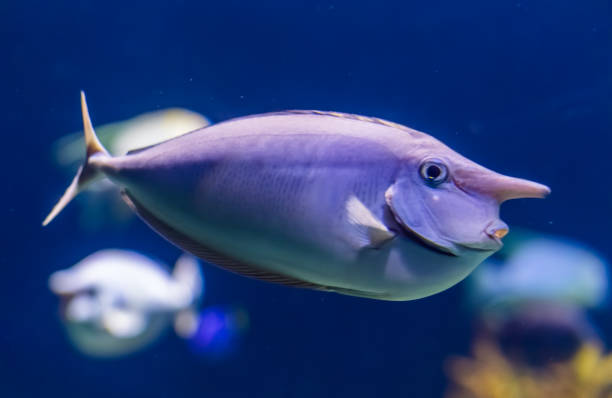
- Scientific name: Naso lituratus
- Weight: May weigh more than 900 kgs
- Where are they found: Indo-Pacific regions, Africa and Hawaii
These fish range from blue-green to olive colour. Also widely known as the unicorn fish, they have horn-like projections on their heads. All the fish of this family have sharp blades on their tails.
The surgeonfish use these retractable blades on their tail for self-defense mechanisms. A surprising attribute of these tails is their bright color.
The different colorado the unicorn fish indicate where they come from. The bluespine and orangespine fish eat the bottom-dwelling algae. Those that feed on plankton may be found at depths of 700 feet.
15. Trumpet Fish
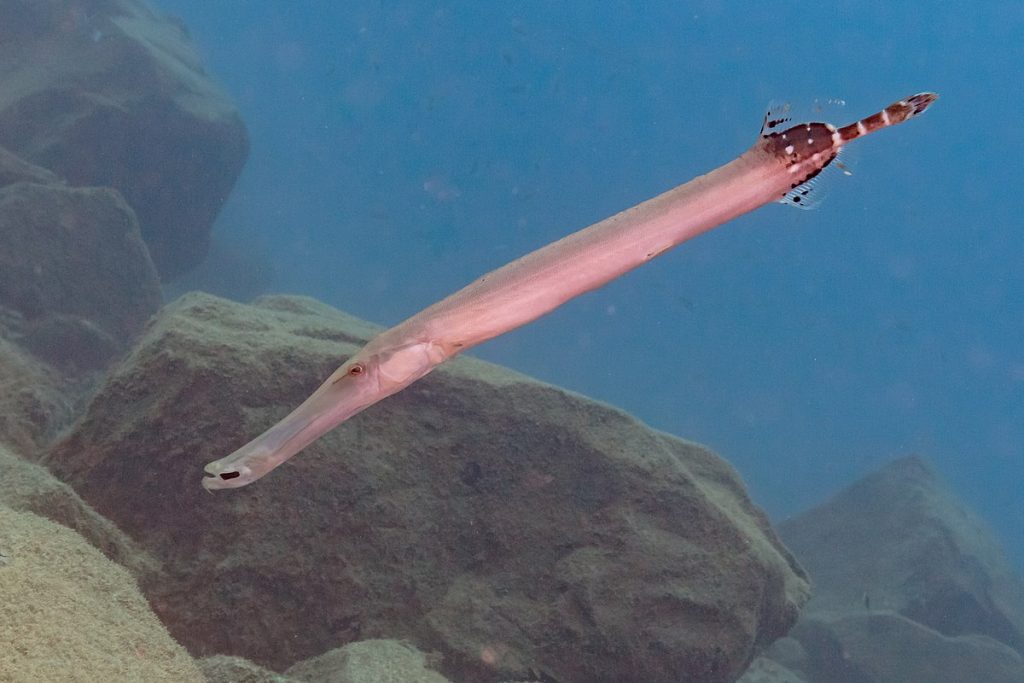
- Scientific name: Aulostomus maculatus
- Size of trumpet fish: 24 to 39 inches
- Where are they found: Atlantic, Indian and Pacific Oceans; also some other coral reefs
Trumpetfish have elongated bodieswith tubular snouts. The upper jaw of trumpetfish does not have teeth, however, the lower jaw has some teeth.
These fish are reef predators that feed on small fish and other invertebrates. They stalk their prey and then ambush them, undertaking high-speed pursuits.
Courtship of trumpetfish occurs near the surface, where the males keep changing their colors to attract other female fish. The appearance of trumpet fish makes them popular for keeping in aquariums.
16. Pinecone Fish
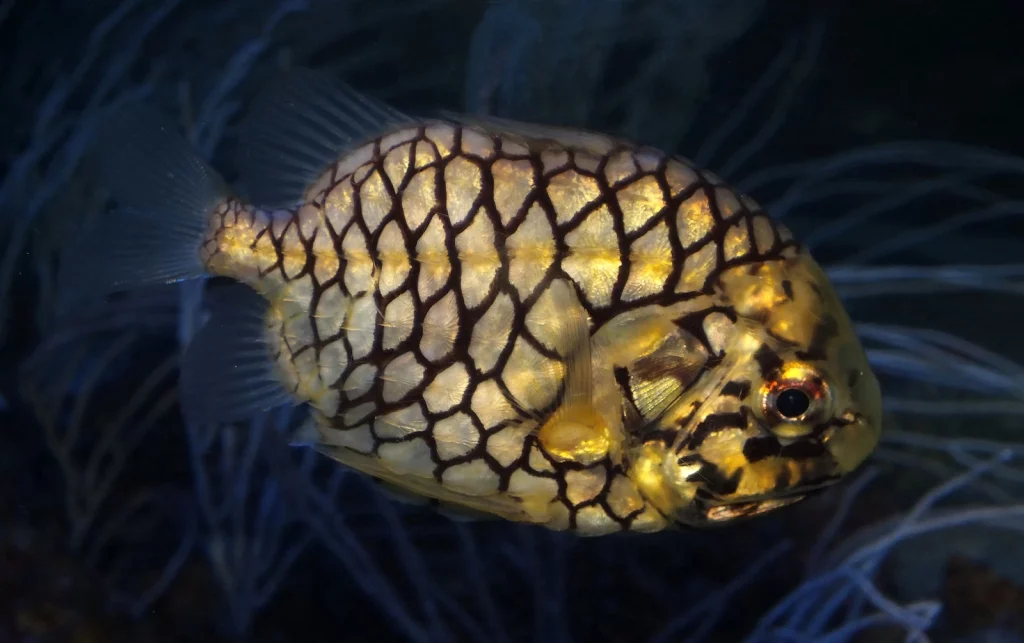
- Scientific name: Monocentris japonica
- Size: 5 inches
- Where are they found: deep-sea environments like Pacific Ocean
Pinecone fish are found in deep water marine habitats of the Indo-Pacific regions. They get their names because of their cone-like structure with spiny scales. The Japanese pinecone fish reaches up to a length of 5 inches.
These fish are kept in tropical aquariums because of their unique appearance. They are very active during the day and tend to hide during the night. Pinecone fish are usually yellow or orange in color with their scales outlined in black.
17. Surgeonfish
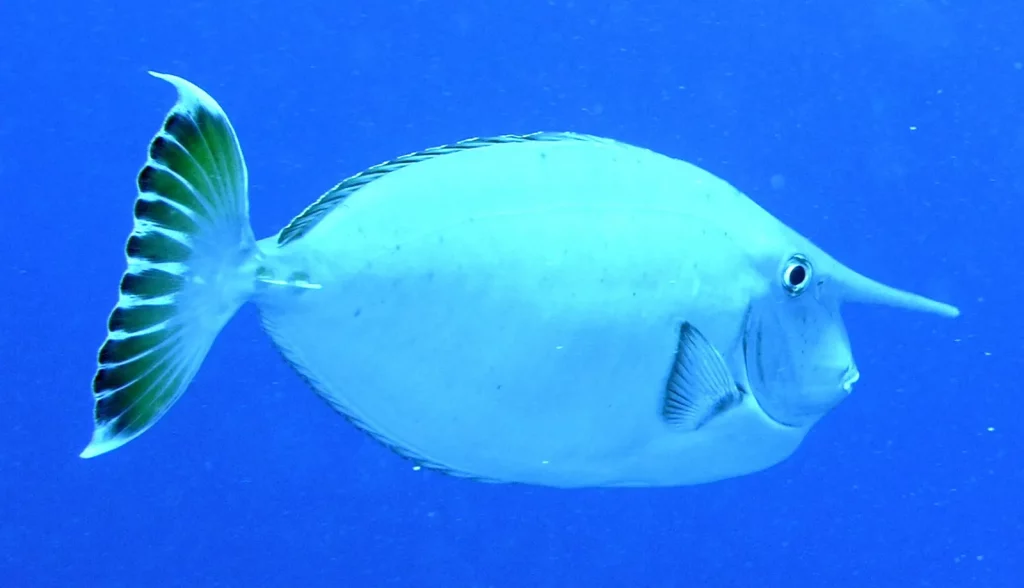
- Scientific name: Acanthuridae (family)
- Weight: Around 600 g
- Size: 7.87 inches to 6.5 feet long
- Where are they found: Caribbean Sea, Atlantic Ocean and the Gulf of Mexico
Surgeonfish get their name because of the sharp scalpel-like ends that they have near their tails. While these fish tend to keep to themselves, they can attack humans if the humans attack them first.
People admire these fish due to their vivacious and vivid colors. In the natural environment, these fish clean up the algae found on coral reefs.
The males of these fish species change their colors when they need to either breed or fight. The entire genera of surgeonfish tends to be herbivorous, except for Naso, a sort of unicornfish that eats plankton.
18. Napoleon Wrasse
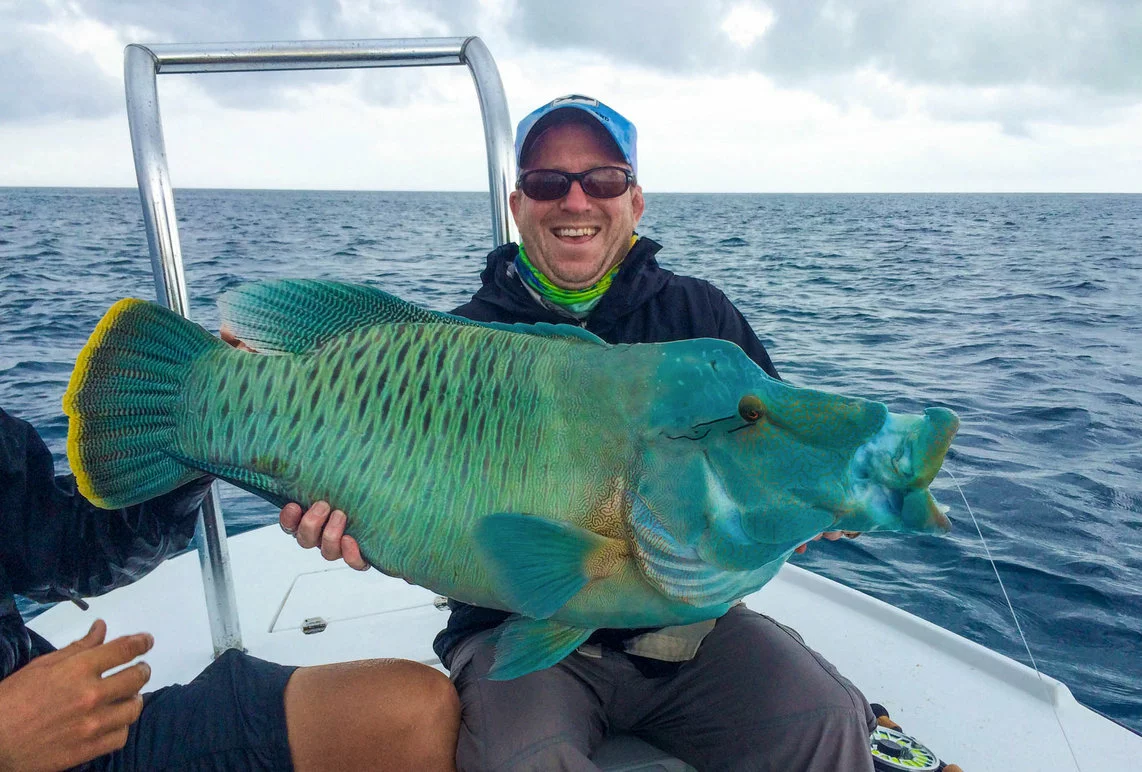
- Scientific name: Cheilinus undulatus
- Size: 7.5 feet approximately
- Weight: around 420 lbs.
- Where are they found: Pacific and Indian Ocean, Red Sea
Napoleon wrasses live on lagoons and reefs at depths of up to 200 feet. They are found in Pacific and Indian Ocean and even the Red Sea. These fish are born with both male and female sexual organs.
They usally live solitary or in pairs. These carnivorous fish eat shellfish, sea urchins, sea crabs and other sea anemones. They also feed on toxic species such as boxfish and even sea hares.
According to some studies, Napoleon wrasses communicate with moray eels to aid each other in hunting. These species are now endangered, because they are highly sought after as food sources primarily in Asia.
19. Dragon Wrasse
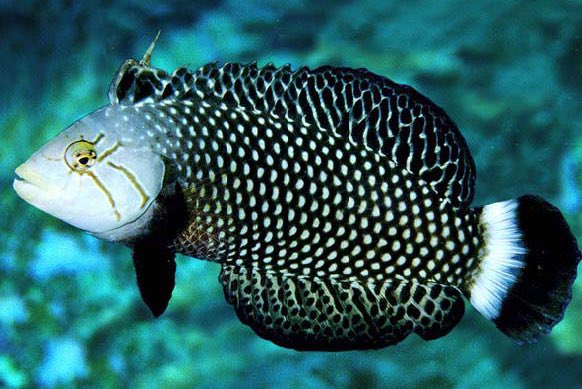
- Scientific name: Novaculichthys taeniourus
- Weight: 8 lbs. approximately
- Where are they found: Indo-Pacific region, Red Sea and Western Pacific Ocean
The Dragon Wrasse, often referred to as the Rockmover Wrasse, has a different kind of appearance. As juveniles, the dragon wrasse fish have a dainty appearance.
They are usually reddish or brown in color with white speckles. Adult dragon wrasses are dark green with plenty of white spots on their bodies.
Adult dragon wrasses are powerful fish that work well in teams. Whenever they feel threatened, these diurnal fish bury themselves in sand or hide in the reefs. These fish usually rely on their vision to locate their preys first.
20. Longhorn Cowfish
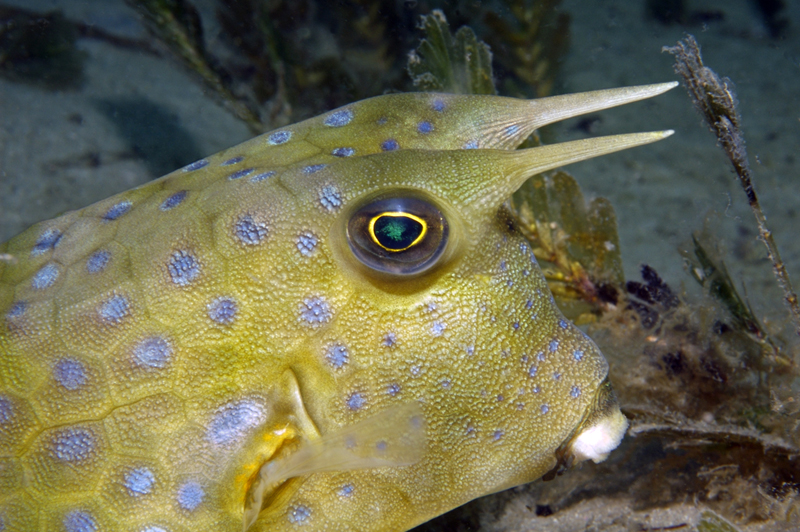
- Scientific name: Lactoria cornuta
- Size: 1”- 4-¾ inches
- Weight: 26 g to 33 g
- Where are they found: Tropical Indo-Pacific region and Red Sea
The longhorn fish usually inhabit the lesser turbid waters of the Indo-Pacific. They are tan to yellow colored, covered in blue and white dots.
The Longhorn Cowfish species should be the first of its kind to be introduced to a fish tank. This is because it is intolerant of other fish species.
Like other boxfish, the Cowhorn fish releases a toxin that is lethal to other tank members. As they are omnivorous, they should be given meaty and leafy foods at the same time.
Why Certain Fish Species Have Big Forehead And Some Do Not
Different kinds of fish from the saltwater and freshwater environments have modified facial structures. These modified facial structures provide numerous benefits to the fish, including helping them to defend themselves. Besides helping them in deterring their predators, it may even help them to attract their prey.
Some of these facial structures appear as large humps or bumps on the foreheads of the fish. While males have slightly larger humps on their foreheads, the humps on the foreheads of the female fish are much smaller.
This kind of bump on the fish’s forehead, also referred to as the nuchal hump, can be seen on cichlids and other such marine species. The overall advantage of this nuchal hump remains the same for all species of fish that have this. They utilize this hump for mating, self-defense and for foraging.
Conclusion
To conclude, different kinds of fish have evolved features that help them survive and get an advantage in aquatic environments. Some of these fish have evolved a unique adaptation known as a nuchal hump or bulged-out foreheads.
These unusual traits, which can be used to break hard coral, attract mates or even gives the fish their ability to hide from predators, have evolved over centuries.
As we delve deeper into the aquatic or underwater realm, we will discover more wonders of the nature or wonders of the aquatic habitat.
These unique sea creatures or wonders have the trait to adapt and change according to their surroundings because of their unique physiological structures like the bulged out foreheads.
Hopefully, the next time you encounter a fish with a big forehead, you’ll have a deeper appreciation for the fascinating reasons behind it! Till the next read then.
Fun Facts or FAQ
What is a goldfish with a big forehead usually called?
It is known as an Oranda, characterized by a bubble-like growth on its forehead. The head growth could be a prominent growth or it may encase the entire face.
Why do some goldfish have big foreheads?
Some goldfish have excess tissue called the “hood” on their foreheads. This can be a problem too. This is because it may hinder their eyesight, breathing, and swimming.
Why do some fish have such big foreheads or bumps on their heads?
Some fish develop big foreheads as a characteristic trait to attract their mates. Others develop this as an adaptation to forage for food or hunt or even to swim better.
How do fish with big foreheads, like the Parrotfish, benefit coral reef ecosystems?
Parrotfish prevent the build-up of excess algae on reef-building coral. Thus, they help to maintain the diversity of the coral reef ecosystem.
Do flatfish face any challenges due to their flat bodies with unique head shapes?
Flatfish do not face any challenges due to their flat bodies because their narrow profile helps them to hide easily from predators. They have protruding eyes to understand the surrounding area of the water better.

![20 Hilarious Fish With Big Foreheads [+photo]](https://exoticpetia.com/wp-content/uploads/2024/01/hilarious-fish-with-big-head.jpg)

